Europe’s largest decentralised memorial is artist Gunter Demnig’s Stolpersteine—‘stumbling stones’— small brass plaques installed in the pavement in front of the former homes of victims of Nazi persecution.[1] The plaques are controversial, and have been celebrated, imitated, and vandalised, triggering myriad afterlives.[2] These installations are counter-memorials, a genre of art and memory activism. They are alternative sites of commemoration, creating uncharted, improvised, unscripted modes of memory. Undermining popular versions of history, and even national narratives, counter-memorials emerge as political experiments clothed as dissenting street art [3] or vernacular events.
What makes some memorials spark a deeply emotional charge, or engender controversy?
What makes some memorials spark a deeply emotional charge, or engender controversy? How do charged sites affect the act of remembering? What does the process of engaging with memorialisation imply? The discussion below grapples with these questions, proposing a new concept, lieux chargés, as an explanatory tool. We explore how, when counter-memorials assume qualities of lieux chargés, they generate afterlives.
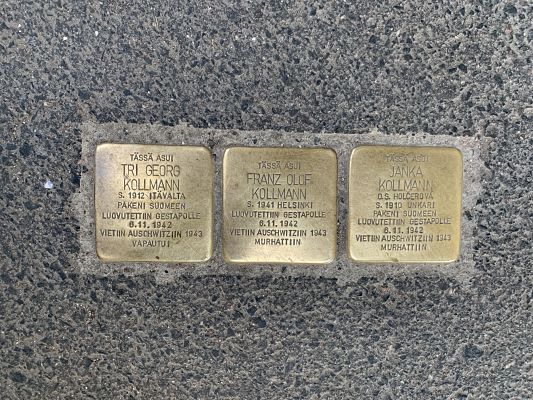
Ethnographic fieldwork with the artist in eight countries over the course of two years, took us to over 50 installations. We observed a range of improvised rituals, interviewing descendants and local participants. The concept of lieux chargés (loosely translated: ‘salient sites’) arose from analysing this research. Lieux chargés conjoins the term objet chargé and Pierre Nora’s notion of lieux de mémoire, but crucially adds a dynamic dimension: the memorials in question are participatory over a longue durée.[4] We recognise the centrality of affective affordances, materiality and time in the conception of lieux chargés. Thus lieux chargés animate the afterlives of counter-memorials.
To date, more than 70,000 Stolpersteine have been embedded in pavements across 26 countries in Europe. On each individual stone the name, date of birth, death, and place of death, when known, are engraved in brass. In the local language, they each begin with ‘Here lived…’[5]
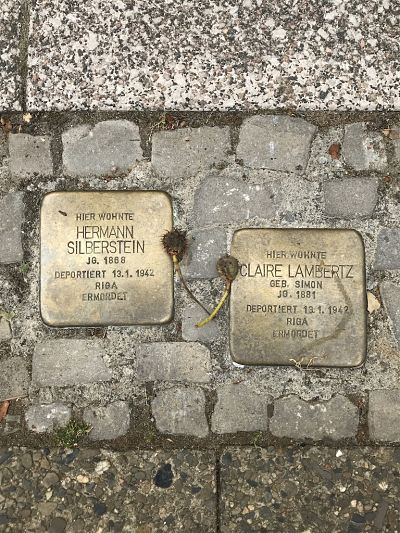
The experience of stumbling across a stone with a name and date of deportation and death, on the very site where the horror was initiated, evokes an intensified sense of the historically charged nature of the site. In this way, Stolpersteine become a part of the material landscape. Carrier suggests that pedestrians who stumble across them are forced to make a moral decision, that is, either to ignore the stone and the name, or, to recognise it (Carrier 2016).
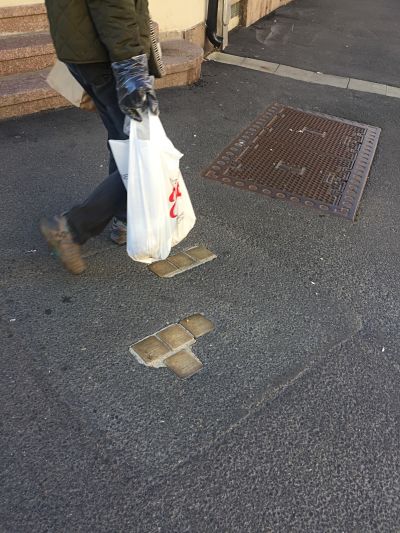
The stones neither protrude nor demand attention; rather, they are quiet, humble invitations to the observer. Typical of counter-memorials, these stones are unexpected encounters; as one observer noted, ‘You may not intend to visit the memorial, yet this one will visit you!’ (Høg Hansen 2008:173).
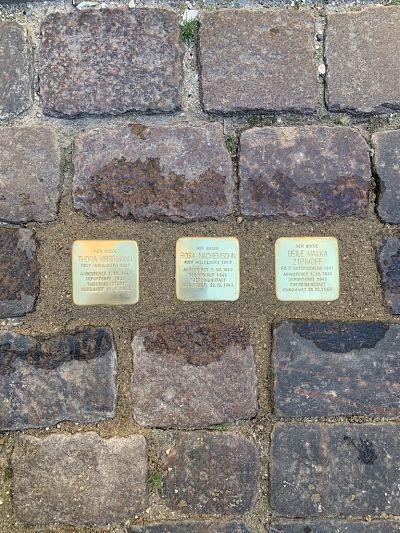
After the stones are installed, the afterlives emerge. People continuously engage with the altered landscape; for example, they follow marked routes to read and contemplate the stones in given neighbourhoods. In both Norway and Denmark we observed primary and high school students researching and visiting Stolpersteine as part of school curricula. Thus the afterlives of Stolpersteine are made manifest through participatory engagement over time.[6]
Stolpersteine beget more Stolpersteine. Originally Demnig created the plaques as a one-off guerilla installation. As the stones attracted attention, descendants of victims began commissioning them for their murdered relatives. Over the past 25 years the project has grown into a massive memory initiative, and stones are commissioned not only by descendants, but municipalities, church groups, schools, museums, and more.
This project has taken on its own iterative logic. The more stones there are, the more they are seen, discussed, and shared, generating further afterlives
This project has taken on its own iterative logic. The more stones there are, the more they are seen, discussed, and shared, generating further afterlives. An interlocutor noted, ‘it’s become like a status symbol–every town needs its Stolperstein.’ To wit, there is a one-to-two year waiting list for new commissions. Furthermore, identifying these memorials as lieux chargés enables a reckoning of the Stolpersteine proliferation as afterlives.
On the road ten months a year installing Stolpersteine, Demnig speaks of his art as his ‘Lebenswerk’ —his life work—stating that ‘everything that happens after I leave the stone is also art.’ Thus does the afterlife of a Stolperstein become an essential dimension of the artwork itself. Demnig is a follower of Joseph Beuys, who coined the term ‘social sculpture’ to embody art’s potential to transform society. The afterlives of the Stolperstein social sculpture might include ceremonies of devotion, stone polishing, individuals stopping and reading, court battles, city bans, vandalism, and articles, books, and films. We observed dozens of ceremonies, replete with improvised rituals drawing from secular and sacred traditions. Hybridised Jewish-Christian prayers, traditional Jewish prayers for the dead, candles, and musical performances and participation (see below). Through his initiative, Demnig not only primes the canvas, waiting for improvised afterlives to emerge, but he is instigating a conversation across time and space.

Stolpersteine serve as material markers in landscapes, provoking myriad emotional reactions and interpretations. Both biographical and historical, they equally can be deeply personal, linking the present to the past. For example, many descendants have remarked that as their relatives perished in death camps, the Stolpersteine have symbolically replaced the absent gravestones. Nevertheless, the artist never intended Stolpersteine to stand for gravestones; rather, they mark a place where people once lived. Following the artist’s vision, events and attention to the stones open the possibility of many ‘lives’ in the afterlives.
Following the artist’s vision, events and attention to the stones open the possibility of many ‘lives’ in the afterlives.
The affective content of lieux chargés was evident at an installation in Berlin. An older woman passing by stopped and listened to the prayers, music, and speeches; she was visibly moved, and her eyes welled up as she spoke about the past horrors visited on this site. Likewise in Copenhagen, two generations of Israeli descendants came to the installation of a stone of their grandfather and great-grandfather. One of them lovingly cradled his great- grandfather’s ring that had found its way to the family after the war.
A central component of Stolperstein installations is music. We observed multiple forms performed at the installations, from the Schindler’s List theme to Ave Maria to sea shanties. But only a Yiddish lullaby brought the assembled–including many elderly survivors–to tears. When the musicians were interviewed, they revealed that this was their aim, choosing music that would emotionally resonate with the people gathered. For Demnig too, the affective dimension is part of the social sculpture; he says he calls them stumbling stones, hoping people will ‘stumble with their hearts and minds.’

Thus do materiality, the sensorium, and affective affordances mutually reinforce the emotional charge of such moments and places, made meaningful as past and present converge.
Thus do materiality, the sensorium, and affective affordances mutually reinforce the emotional charge of such moments and places, made meaningful as past and present converge. Taken together, the power of Stolpersteine expands exponentially, in a multiplier effect, as part of the internationalization of Holocaust memorialisation. Crucially, Stolpersteine paradoxically juxtapose a unique but identical material object. In other words, while reflecting the individualised specificity of the person memorialised, they are unified by their international conformity. These intersections render Stolpersteine so very charged, a quintessential expression of lieux chargés.

******
We acknowledge the enthusiastic support of numerous individuals and organizations who facilitated the field research on which this article is based. The input of our research assistant, Djan Sauerborn, was invaluable throughout, as was Grace Ioannidou’s support during the Greek research. The Jewish Museums of Oslo and Trondheim, municipalities throughout Norway, The Living History Forum in Stockholm, HUM in Finland, Anne Thomas and Gunter Deming of the Stolpersteine Foundation, and the organisers of the installations in Thessaloniki and Veria, all provided crucial support.
Countless people spanning 7 countries took the time to be interviewed and share their uncensored emotions, reactions and personal histories, as did those who allowed us to participate in their own Stolperstein installation ceremonies.
The two Allegra Lab readers, Duane Jethro and Banu Karaca, provided thoughtful and useful improvements.
******
[1] Stolperstein is singular, Stolpersteine plural.
[2] A longer, more in-depth discussion of lieux chargés and related topics can be found in Mandel and Lehr, ‘Failing to Remember: Afterlives and Stolpersteine in the Nordic Region,’ in Journal of Jewish Studies, forthcoming, 2020.
[3] For a discussion of a Holocaust street art counter-memorial, see Chapter 4, in Ruth Mandel, Cosmopolitan Anxieties: Turkish challenges to citizenship and belonging in Germany.
[4] The objet chargé can be a salient object with a potential for fetishisation (Spyer 1998); it implies an “ability to capture the fascination of the viewer, and above all to disturb the surrounding space…’ Jean-Michele Sanejouand
[5] The brass stones commemorate Jews, Roma, Sinti, homosexuals, dissidents, Jehovah’s Witnesses and victims of euthanasia.
[6] Stolpersteine in Budapest ; stolpersteine-berlin.de ; culturalgems ; Hjemme Borte
Featured image by Ruth Mandel and Rachel Lehr.


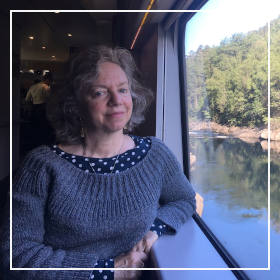




When I lived in Berlin a few years ago, my friends Joseph (from Canada) and James (from the US) organized the sponsoring of a ‘Stolpersteine’ memorial in honor of two unknown neighbors of theirs who had been deported during the holocaust. None of us was related to these two sisters in any personal way but this impromptu memorial felt like we were doing our part in keeping their memory and more largely the memory of the holocaust alive. This post reminds me of this gesture of collective resistance against oblivion.
My friend Joseph also wrote about it on his blog:
http://needleberlin.com/2016/10/19/sponsoring-stolpersteine/?fbclid=IwAR0LCu0uR6MT4_L71IIjfzJaYjI-he8T-xyZ8rFVQDdNcZfQUg6ztOnRvpc
gratifying to learn that the stolpersteine have become so institutionalised and interwoven into the fabric of local life and memory across such geographic breadth and diversity– unique in the vicissitudes and discontents of contemporary commemorative culture and well done you for bringing the whole phenomenon to scholarly attention and analysis– “minumentality”– always puts me in mind of Sebald…